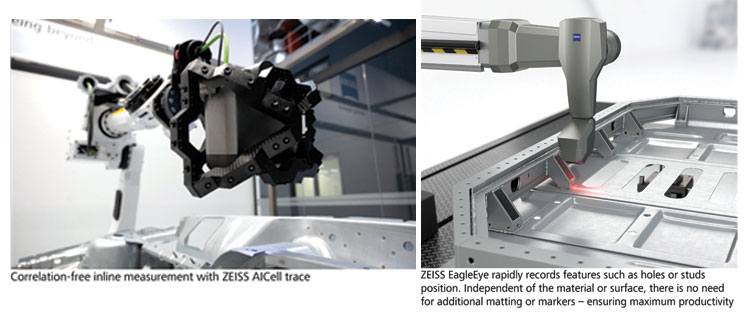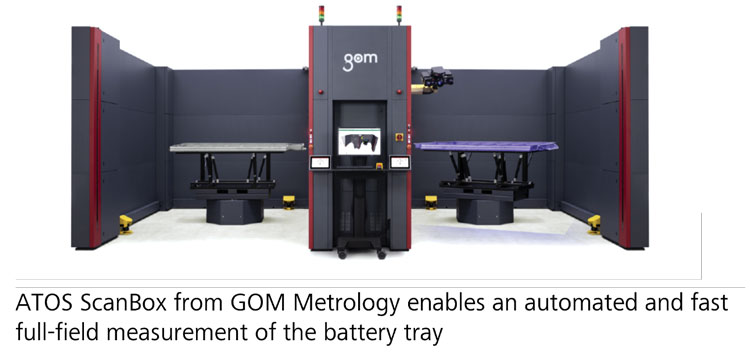Manoj Sundaram, Head of Business development, Carl Zeiss, takes a deep dive into Battery Tray manufacturing and talks about ZEISS know-how on the Quality gates at each of the production process, challenges involved and solution available with ZEISS at each gate.
Q. Why Battery Trays need a holistic Quality Process?
The battery tray is not just another part of an electric vehicle – it is the new core component serving as the interface between the drive and the structural element. For manufacturers and material suppliers, it holds complex conceptual tasks:
The battery must be crash- and leak-proof, should be corrosion-resistant, electromagnetically shielded, and cooled.
Characteristics as flatness, fixing points for the battery cells as well as position tolerances are important to ensure the high performance of the battery package.
Hence we have defined five quality gates along Battery Tray Production, which need to be mastered thoroughly to ensure the overall safety requirements and quality of the vehicle. These quality gates are: Joining process control, Milling & Drilling Process control, Full field Inspection, Critical Functions Control and Structural Analysis. This is what we called the ZEISS Blue line Process and Quality gates for Battery tray inspection.

Joining Process Control
For this quality gate, dimensional control inside the Welding process is where the main challenges are. A large number of characteristics are required to be measured in a quick inspection time and the quality request is the 100%-dimensional control of the welding processes. We have the pleasure to show you our innovative correlation-free Inline system AICell Trace for this Quality Gate. The AICell Trace can acquire reliable correlation-free and traceable measurement. It is an Inline metrology system which can inspect every single part produced and meet the requirements of the DIN / ISO 10360-8 standard. This means it is your CMM, integrated with robot solutions in your production line; in other words Metrology directly in your production line.

Milling and Drilling Process Control
Next is the Quality gate Milling & Drilling Process control, where the challenges are milling & drilling where the Production process control is to be in production cycle/lead times. There are high number of features with tight tolerances and require precise and quick inspection cycles, which is directly in production environment, integrated with your production systems. Here we have our solution: ZEISS Caleno which combines fast and precise feature measurement, with high performance of optical and tactile sensors. It has thermal insulation and protection against dust and dirt in the working environment, which enables this technology to work directly in the production lines.
Full-Field Inspection
This quality gate, the focus is the complete digitalization of the part, and how visualization tools can be used for quick analysis. The analysis of complete sealing areas as well as matching areas for the battery cells and battery modules is to be done, which has the risk of low performance of battery if they are not right or positioned correctly. We have a solution for Digital twin and digital assembly: ATOS ScanBox, which can generate a full Digital Twin of your battery tray and battery cells as well do color mapping reports. This can be done easily using this technology and the powerful GOM inspect PRO Software, to create your digital assembly’s understanding and anticipating possible concerns.
Critical Functions Control
The final safety check and certification of the complete battery tray represents a special challenge. Safety critical characteristics consist mostly of a complex welded aluminum profile that underlies thermal expansion when temperature increases e.g. during charging and driving. This can lead to torsion and bending in the tray and may cause serious safety issues. Hence there is a need for the certification of the part (initial Sample) with very tight tolerances and as well accomplish with all MSA standards. Here ZEISS Bridge type CMMs which are very precise can help. Multisensoric ZEISS Coordinate Measuring Machines (CMMs) offer a big measuring field and allow the usage of both tactile and optical sensors on one machine. Combined with the powerful ZEISS software CALYPSO and PiWeb, CMMs allow to compare and correlate measuring results inline as well as at line. We have CMMs available with optical and tactile sensors, ensuring you the right accuracy to certify your products.
Structural Analysis
It is always a challenge to see inside the parts, because critical defects in the inner structure can emerge during the manufacturing process and it is essential to distinguish between good and scrap. It is also a challenge to determine the size and position of those defects such as weld seams, casted structures, glue analysis and sealing.
ZEISS 2D and 3D X-ray technology can detect, locate, classify and rate internal defects as cavities, pores, cracks in the critical areas to identify defective battery trays.
Systems, such as ZEISS METROTOM, digitize complex parts at the finest level of detail, even from the inside, in a fast an efficient way. Making the invisible visible is the key to a reliable production process.

You can connect with us to know more on the solutions we have for Electric vehicles and their safety at [email protected] and we will be happy to provide with more information.


